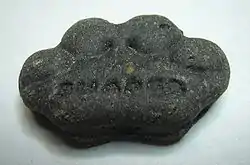Charcoal in food
Charcoal is used in food to colour it black and for its supposed health benefits.

Activated charcoal is used as a food ingredient. This is typically made from bamboo or coconut shell. It gives food an earthy, smoky taste and the black colouring gives the food an exotic, fashionable appearance.[2]
Health benefits have been claimed for charcoal back to classical times, when Hippocrates and Pliny recommended it for conditions such as anthrax and vertigo. Activated charcoal adsorbs chemicals and so may bind to both toxins and vital nutrients such as vitamins; it may make prescription medications less effective. Its effects are therefore broad and indiscriminate.[2][3]
Chefs and food retailers that have pioneered the use of charcoal in food include Ferran Adrià, Burger King, René Redzepi, Simon Rogan and Waitrose.[4][5]
See also
References
- Victoria Chandler (1 June 2017), "Waitrose has launched black-based charcoal pizza", Good Housekeeping
- Rebecca Nicholson. Morwenna Ferrier (28 June 2017), "It's in smoothies, toothpaste and pizza – is charcoal the new black?", The Guardian
- Torrens, Kerry (2018-12-04). "What is activated charcoal and is it safe?". BBC Good Food. Retrieved 2020-10-11.
- Jamie Waters (9 April 2015), "Charcoal has become the hot new flavouring in everything from cocktails to meat and mash", Independent
- "Charcoal food trend: where to eat it and how to cook with it", Olive, 11 August 2015

